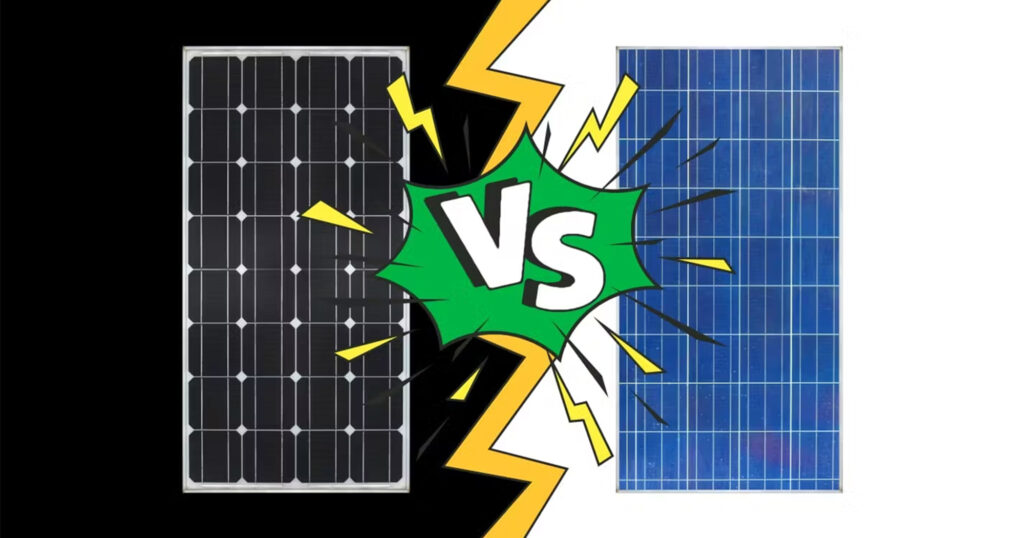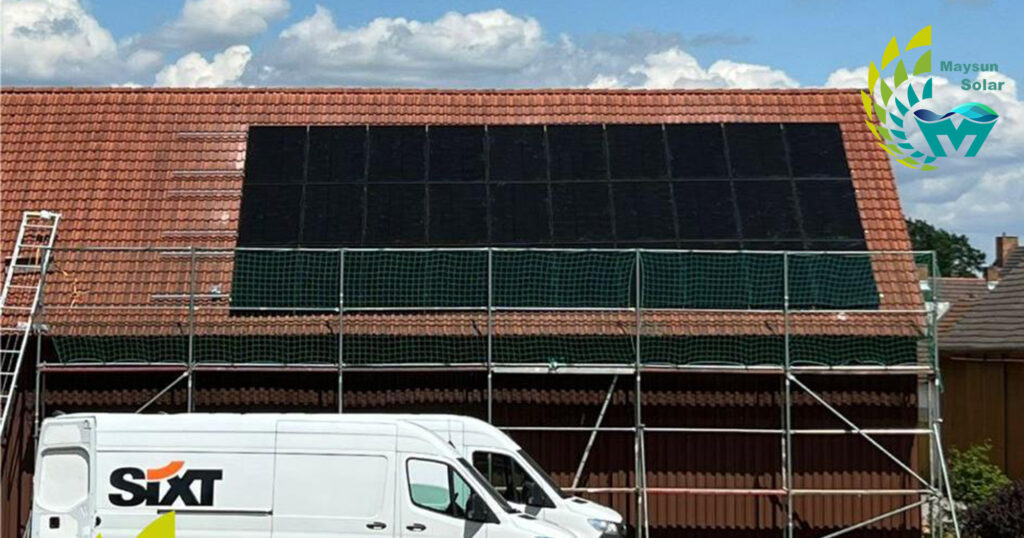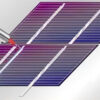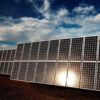Do you know the difference between monocrystalline and polycrystalline solar panels? In this article, we will tell you in detail!
What are the differences between monocrystalline and polycrystalline solar panels?
1. Silicon:
Polycrystalline Silicon: A production process in which silicon crystals are melted and poured into square molds, cooled, and formed into polycrystalline solar cells. Polysilicon produces less silicon waste and requires less energy to form, making it less expensive.
Monocrystalline silicon: High-quality silicon crystals are used to make monocrystalline solar cells. During the production process, the silicon is arranged in a single direction to form one large crystal.
2. color:
The process of producing monocrystalline panels creates many individual crystals, resulting in a speckled, shimmering appearance that appears blue to the human eye.
Due to the way the monocrystalline panels are arranged after production, they appear black to the human eye under light interacting with the monocrystalline cells.
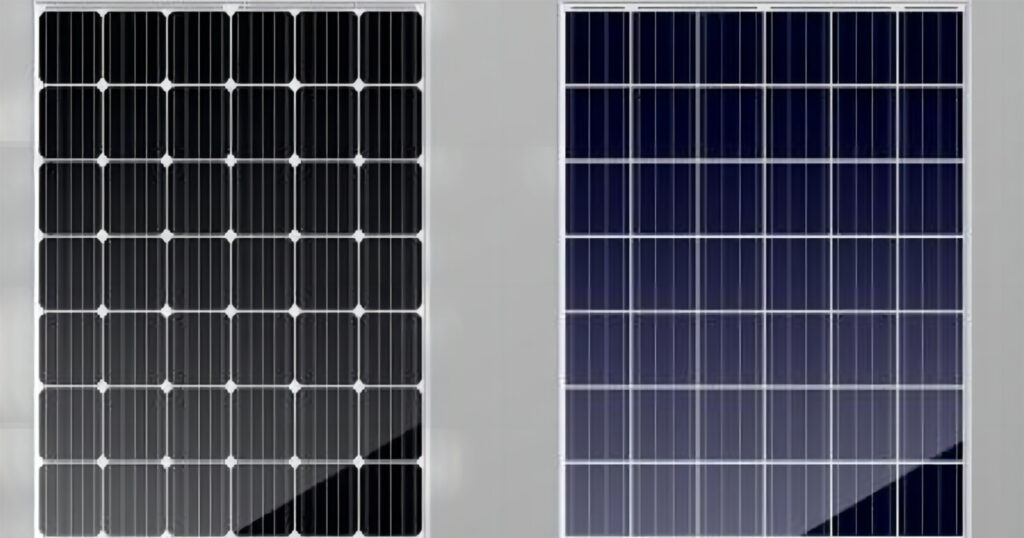
3. Efficiency Rating:
Polycrystalline panels have lower efficiencies, typically in the 13–16% range. Monocrystalline panels are more efficient, usually in the 15-20% range.
Tip: Monocrystalline panels lose some efficiency due to color drop. In addition, monocrystalline panels not only heat up faster, but also trap less light. Both of these factors reduce efficiency. However, the efficiency reduction caused by these factors is only about 0.5%, which is basically negligible.
But overall, monocrystalline panels are still more efficient than polycrystalline solar panels. If you’re located in a cooler region with lower latitudes, you won’t have to think about a drop in efficiency.
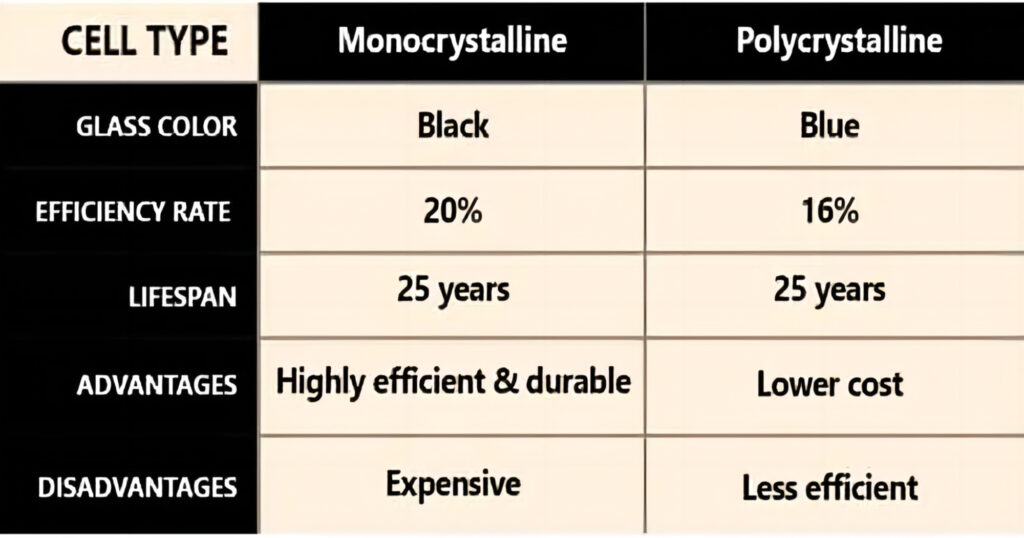
4. Costs
Polycrystalline panels: lower cost due to the simple process of manufacturing polycrystalline solar panels.
Monocrystalline Panels: Monocrystalline solar panels are more costly due to the complexity of the process used to manufacture them.
With the development of technology, the cost of monocrystalline panels is getting lower and lower. A 410W monocrystalline solar panel from Maysun will cost you about €100. It is a good choice for you!
Monocrystalline vs Polycrystalline, which solar panel should I choose?
Now that you understand the basic differences between monocrystalline and polycrystalline solar panels, you may be wondering if monocrystalline panels are a better choice than polycrystalline panels for home solar installations.
Due to their monocrystalline structure, monocrystalline solar panels absorb light and produce electricity more efficiently than polycrystalline solar panels. Since fewer cells are needed to produce the same amount of electricity, monocrystalline panels are usually cheaper in the long run and take up less roof space.
Here are four questions you should answer when determining how many PV panels you need for your home:
- What is your household’s energy consumption history?
- What are the peak daylight hours in your area?
- What is the output of each solar panel you are considering?
- What are your solar goals?
The latest generation of monocrystalline solar panels lasts longer than polycrystalline solar panel models. They also perform better in higher temperatures and low light conditions than blue panels. Even if the amount of power generated slowly deteriorates over time, the panels will still produce enough energy to meet your home’s electricity needs for 25 years (and often longer).
Compared to polycrystalline, monocrystalline panels have become the mainstream of the market, and polycrystalline solar panels also have a variety of shapes to choose from, such as black frames, all-black frames, silver frames, etc., in order to meet the needs of customers in different application scenarios.
Full black monocrystalline panels
An all-black panel is a solar panel based on monocrystalline panels; the backsheet, frame, and appearance are all black. He is a new aesthetic solar cell version. It has become a new favorite in Europe, especially in the Nordic region.
Maysun’s all-black solar panels, on the other hand, use black-glazed ceramic glass with a black anodized aluminum alloy frame, giving the modules a perfect all-black appearance that blends into the elegant European architectural aesthetic. At the same time, the all-black modules absorb heat faster and can melt snow faster in cold areas, thus increasing power generation efficiency.
Maysun works with a number of national suppliers and has assisted many customers with the installation of all-black solar panels.
Maysun Solar has been specializing in the production of high quality photovoltaic modules since 2008. We have a wide range of products, including monocrystalline and double glass solar panels in addition to shingled, with half-cut, MBB and IBC technologies, which provide superior performance and stylish design to blend in perfectly with any building. Maysun Solar has successfully set up offices and warehouses in many countries and has established long-term relationships with excellent installers! For the latest module quotation or any PV related inquiry, please feel free to contact us.
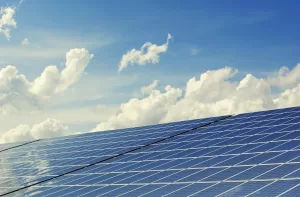
Which solar modules perform better under high summer temperatures?
Can high summer temperatures reduce the power generation efficiency of solar modules? This article compares the performance of HJT, TOPCon, and IBC modules under high temperatures to help you make informed choices and optimize your return on investment.

Structural Risks and Component Adaptation Strategies for Commercial PV Deployment under Extreme Weather Conditions
A comprehensive analysis of the structural risks and component configuration strategies for commercial and industrial PV systems under extreme weather conditions, helping businesses enhance system stability and long-term energy yield.

How Can Photovoltaics Help Businesses Cut Peak Electricity Costs During Summer Price Spikes?
How Can Businesses Use Photovoltaic Systems to Address Summer Electricity Price Peaks? This article provides cost-saving calculations, suitability conditions, and technical selection recommendations.

How to Detect Hotspots and PID Effects in PV Modules to Prevent Long-Term Losses?
How to identify and respond to hotspots and PID effects in PV modules? This article focuses on the European market, combining detection technologies, real-world cases, and protection strategies to provide developers and investors with reliable loss warnings and yield protection solutions.

How to Choose the Most Suitable Solar Panels for Commercial and Industrial Use in 2025
How can commercial and industrial projects choose the right solar panels in 2025?
This article provides a systematic comparison of mainstream panel types such as TOPCon, HJT, and IBC, analyzing their advantages, disadvantages, and suitable applications. It aims to help businesses make accurate selections based on specific project conditions, thereby improving long-term energy output and return on investment.

After the Iberian Blackout How Can Enterprises Reshape Their Energy Security Systems
The 2025 Iberian blackout drew widespread attention across Europe. This article analyzes grid vulnerability, enterprise energy risks, and the deployment path of “solar + storage + EMS” systems to help businesses build a controllable and secure energy structure.

